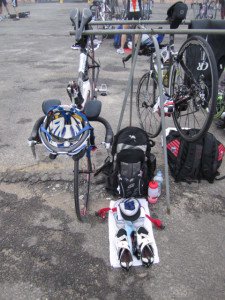You’ve done all this swimming, biking, and running to get ready for your race, DON”T FORGET to practice your transitions from one discipline to the next! I can’t tell you how many beginners, AND veterans forget to PRACTICE their transitions! Follow this guide below to make sure you’re prepared on race day!
Transitions: Set up
The best transition set up is the simplest! You do not have a lot of space, so the athletes with the fastest transitions are usually the ones that are the most organized and efficient with their set up! Use the K.I.S.S. method (Keep It Super Simple) and you’ll be in and out of T1 and T2 in no time at all! Races can be won in transition (I’ve seen it!), so take my advice for making them as smooth as possible.
Transitions: Swim to Bike T1

K.I.S.S. Method
A good T1 starts with the set up before the race begins. The fastest people are the most organized, so, the best approach is to use the K.I.S.S method (Keep It Super Simple!), and keep it as simple as possible.
The first thing to do is make a check list to ensure you have everything you will need for your race.

Typical crowded transition area
Your Bike! Nutrition (sports drink, fruit drops, etc.) Helmet Socks (optional)
Sunglasses Swim cap Body Glide Goggles (two pair just in case)
Baby powder Wetsuit Towel Running shoes Bike shoes
Race number belt ` Timing chip Sunscreen
The next step is to have a “plan of action,” and practice, practice, practice! For example:
Bike Set Up:
1 – Hang your bike by the seat facing out in the direction you want to go
2 – If you have aerobars, rest your helmet upside down on the aerobars with the straps open wide and the front of your helmet facing out toward you. Make sure to also adjust the tightening dial (if you have one) on the back of your helmet to its loosest position for ease of putting on. If you do not have aerobars, place your helmet in the same position on top of your towel or bike or running shoes.
3 – Place your sunglasses inside your helmet.
4 – If you’ve practiced this, have your bike shoes clipped into your pedals and secured using rubber bands in a horizontal position with the Velcro straps open wide for easy entry on the bike. If not, place them on your towel, again open wide for ease of entry. You may also want to have powder inside as well as Bodyglide the heel to help dry your foot and prevent chafing.
5 – Have all of your nutrition in place on your bike.
Swim & Wetsuit Prep:
1 – Generously apply body glide to any area that may provide friction or cause chafing. (All around your neck, ankles, wrists, Lats, and triceps – for those using sleeveless wetsuits, and feet)
2 – After zipping wetsuit, create a loop with the cord and then place the Velcro closure over the loop. This will get the cord out of your way when swimming, and give you something easy to grab for when exiting the water.
3 – Place your goggles on first, then your swim cap. This is to help prevent your goggles from being lost if someone accidently (or not), knocks them off during the swim.
Transition Process:
1 – Swim as far up to the shore as you can. You don’t want to start running in water that’s above your knees. It’s faster to swim at that point. Think about grabbing 4-5 handfuls of sand.
2 – When you can stand and run, reach behind your head for the Velcro closure and the cord loop (use both hands). Open the Velcro closure and pull down the cord to unzip the wetsuit.
3 – As you are running to T1 you can do one of two things; a) take off your swim cap and goggles and then peel your wetsuit off of your upper body inside out making sure to leave the swim cap and goggles inside the sleeve (if you have them) as you pull your arm out (you won’t lose them they’re all rubber and will stick together), or b) just peel off the upper portion of your wetsuit then your swim cap and goggles and run with them in your hand.
4 – When you get to your bike peel off the bottom half of your wetsuit by bringing it down as far as you can with your hands, and then use your feet to get it all the way off. The water that is still soaked into your wetsuit should remove any sand, grass, or debris from your feet.
5 – If you need to, wipe your feet on your towel, and at the same time grab your helmet and sunglasses. Put on your sunglasses, and then your helmet. (If you want, you can take a swig of water just to rinse the salt water out of your mouth)
6 – If your shoes are on your towel, put them on and run to the bike mount outside of T1. If your shoes are on your pedals, grab your bike and immediately run to the bike mount. Once on your bike with a little momentum, slip your feet into the shoes and tighten the Velcro. The rubber bands will break off when you start pedaling.
You will not be allowed to leave transition without your helmet clipped on! Your nutrition should already be on your bike!
Transitions: Bike to Run T2
Of the two transitions involved in triathlon, the bike to run transition should be the faster and less complicated of the two. Since you are not changing the medium from which you are competing (water to air for swim to bike transition) in T2, there are less things to slow you down (wetsuit, goggles, swim cap, sand, grass, etc.). In both transitions, however, the fastest people are the most organized.
The best approach is to use the K.I.S.S method (Keep It Super, Simple!), and keep it as simple as possible.
The first thing to do is make a check list of items you’ll need for the Run, and double check that you packed all items. An example is as follows:
Towel Running shoes
Socks (optional) Powder
Bodyglide/Vaseline Race cap/visor (optional)
Number belt Sunglasses
Fuel Belt/hydration belt (optional)
Nutrition/gels, bars, etc.
The next step is to have a “plan of action,” and practice, practice, practice! For example:
1 – In the last kilometer coming off the bike slip your feet out of your bike shoes and take the time to drink some sports drink so you don’t have to as you’re changing. It’s best to practice before attempting in a race.
2 – If you’re comfortable, use a “flying” dismount as you approach the dismount line; otherwise come to a complete stop before getting off your bike.
3 – Know where your transition spot is located! Take the time before the race to know exactly where you are in the transition area so when you come in fatigued, you don’t get lost! Believe me, I’ve seen it happen.
4 –Rack your bike by the handle bars. Don’t waste time trying to turn it around and hang it by the seat.
5 – Take off your helmet and lay it on the handle bars.
6 – Put on your socks and have powder in your shoes or use Body glide on your feet if you run without socks.
7 – Put on your running shoes. Make sure that they are already “open wide” for easy foot entry. It’s best to use lace locks (elastic laces) so you don’t have to waste time tying your shoes, and don’t have to worry about them coming undone during the race.
9 – Grab your hat/visor, race number belt, and any nutrition you need, and go! You can put them on as you’re running.
This may sound like a lot, and it can be if you let it, that’s why it’s important to be organized. You need to know where everything is before you get into transition. Make sure to place everything within easy reach. It also helps to visualize every move in your head beforehand. The important thing is not to rush. Stay as calm as you can since you know where everything is, and don’t stop moving! Doing these things will save you valuable time in the fourth event of triathlon, the Transition, and help improve your position in the standings as well.
Coach Jeff Boyer









